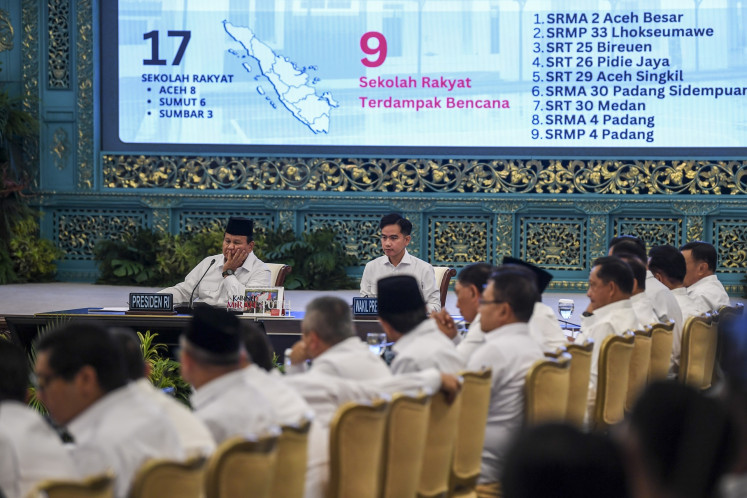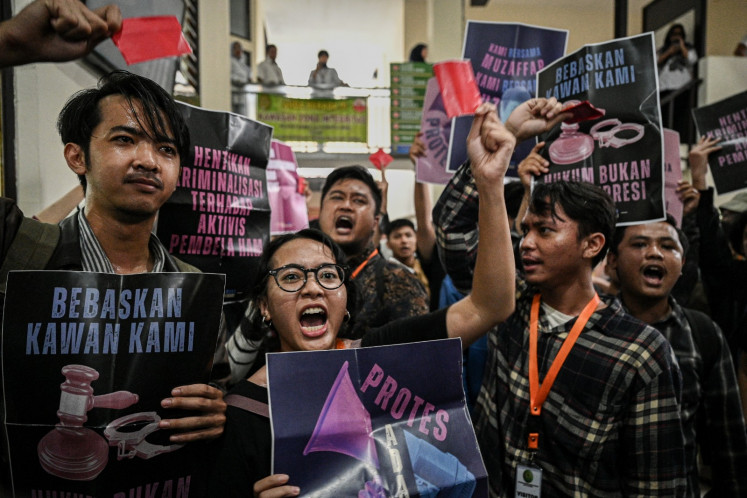Popular Reads
Top Results
Can't find what you're looking for?
View all search resultsPopular Reads
Top Results
Can't find what you're looking for?
View all search resultsInnovators: The bright minds we should be proud of
The cancer treatment device by neuroscientist Warsito Purwo Taruno has sparked controversy lately after its failure to pass safety testing procedures that would qualify the device and treatment for use on patients
Change text size
Gift Premium Articles
to Anyone
T
he cancer treatment device by neuroscientist Warsito Purwo Taruno has sparked controversy lately after its failure to pass safety testing procedures that would qualify the device and treatment for use on patients. The Health Ministry has frozen Warsito's services for patients for the time being.
Meanwhile the Research, Technology and Higher Education Ministry has shown its support for him. It has triggered a debate on how we should support and appreciate our innovators, on the one hand, and our compliance to rules and regulations, on the other. This case is likely just the tip of the iceberg.
There are two issues that deserve our attention. First, how we should treat and manage these bright minds, and second, whether this type of invention and innovation should be considered a potential disruption, or threat to existing competition, deserving to be met with reluctance or defensive measures from established hospitals, doctors, medical suppliers and others.
I personally met Dr. Warsito at one conference I organized and at another one I attended. I was lucky enough to meet and talk to him the night after a conference in Nuremberg, Germany, in 2014 along with some Indonesian students studying there. We spent hours satisfying our curiosities about his experiences and struggles beyond what he had presented in the morning. I felt his determination to make a contribution to his country with both his expertise and his enthusiasm to inspire young people.
__________________________________
Coordination among state departments, such as ministries related to research would surely help here.
We have to recognize the importance of complying with rules and regulations in the medical field before any new devices or methods are introduced.
Therefore, Dr. Warsito as well as other inventors and innovators should get support and guidance through the whole process of obtaining licenses or certification. They should not be left to struggle on their own through the masses of red tape. The spirit here should be to nurture them instead of hold them back.
The following points need to be considered by authorities and decision makers regarding the emergence of these inventors and innovators.
First, since it is not very often one finds these kinds of bright minds, the authorities should approach and nurture them to help them comply with rules and regulations. Do not let them fight alone for their survival. It is a long and challenging task to translate science into new and useful products or devices, so a helping and nurturing hand to deal with demanding requirements of strict rules and regulations will surely be needed.
Second, treat these bright minds with the encouragement and appreciation they deserve, before tempting offers from abroad become irresistible to them. Many developed countries with better facilities and funding would undoubtedly be happy to embrace these people to fill their laboratories and research centers.
Third, the electrical capacitance volume tomography (ECVT) developed by Dr. Warsito has various possible applications, including as a measurement device in manufacturing processes. Support in terms of using and installing this kind of buatan dalam negeri (made-in-country-product) by national and state-owned firms should be encouraged.
Coordination among state departments, such as ministries related to research and that of the state-owned enterprises, would surely help here.
The fear of disruption and competition from new devices and methods developed by Indonesian inventors and innovators is also interesting. Look at the case of GE India. Electro Cardiograph (ECG) machines used to be only available at US$8,000 each; far too expensive for small clinics and physicians. One scan costing $20 is a treatment that patients in rural India simply cannot afford.
GE India successfully found a way to develop an $800, portable, easy-to-use and easy-to-repair ECG to perform cardiac tests in rural India.
This shows that innovation is not necessarily threatening to incumbents. On the contrary, this particular innovation provided healthcare access to middle- and low-income people who would otherwise not have been able to afford the treatment.
Incumbents need not worry, but instead support this type of innovation as innovators should be smart enough to find markets unserved by other providers.
Innovators and inventors are bright minds; rare gems that we should be proud of. We have only a few of them. So, nurture them and let them thrive. Thousands or even hundreds of thousands of others might follow.
_____________________________
The writer is a PhD candidate at Friedrich Schiller University Jena, Germany, and a faculty member at the School of Business and Management at the Bandung Institute of Technology (ITB).










